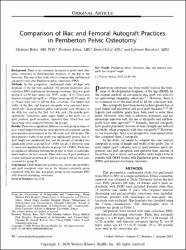| dc.contributor.author | Bulut, Mehmet | |
| dc.contributor.author | Azboy, İbrahim | |
| dc.contributor.author | Özkul, Emin | |
| dc.contributor.author | Karakurt, Lokman | |
| dc.date.accessioned | 2021-10-11T09:06:08Z | |
| dc.date.available | 2021-10-11T09:06:08Z | |
| dc.date.issued | 2021 | en_US |
| dc.identifier.citation | Bulut, M., Azboy, İ., Özkul, E. ve Karakurt, L. (2021). Comparison of iliac and femoral autograft practices in pemberton pelvic osteotomy. Journal of Pediatric Orthopaedics, 41(1), 46-50. https://dx.doi.org/10.1097/BPO.0000000000001665 | en_US |
| dc.identifier.issn | 0271-6798 | |
| dc.identifier.issn | 1539-2570 | |
| dc.identifier.uri | https://dx.doi.org/10.1097/BPO.0000000000001665 | |
| dc.identifier.uri | https://hdl.handle.net/20.500.12511/8413 | |
| dc.description.abstract | Background: There is no consensus in regard to grafts used after pelvic osteotomy in developmental dysplasia of the hip in the literature. The aim of this study was to compare iliac and femoral autografts used after Pemberton pelvic osteotomy (PPO). Methods: In this prospective, randomized study, 60 hips with dysplasia of the hip were included. All patients underwent open reduction, PPO, and femoral shortening osteotomy. Iliac autograft (group I; n=30 hips; mean age, 39.07; range, 18 to 72 mo) and femoral autograft (group II; n=30 hips; mean age, 42.53; range, 19 to 70 mo) were used to fill the iliac osteotomy. The height and width of the iliac and femoral autografts were measured intraoperatively. Anteroposterior pelvic radiographs were obtained on the 45th day, and in the 2nd, 3rd, 6th, and 12th months postoperatively. Acetabular index angle, height of the graft, loss of graft position, graft resorption, operative time, blood loss, and union time were compared between the groups. Results: There was a significant difference in each group in terms of loss of graft height between the intraoperative measurement and the postoperative measurement at the 6th week and 3rd month. The intraoperative width of the grafts was significantly greater, loss of graft height was significantly less, and the amount of bleeding was significantly lower in group II (P<0.001 for all 3). However, time to union was significantly shorter in group I (P<0.001). There was no significant difference between the groups in terms of acetabular index angle at the last controls. There were loss of graft position in 2 cases and graft resorption in 1 case for group I, but no such cases occurred for group II. Conclusions: Graft height and position loss, donor site morbidity, and graft resorption were less in the femoral autografts group compared with the iliac autografts group in the treatment PPO with femoral shortening osteotomy. | en_US |
| dc.language.iso | eng | en_US |
| dc.publisher | Lippincott Williams & Wilkins | en_US |
| dc.rights | info:eu-repo/semantics/embargoedAccess | en_US |
| dc.subject | Pemberton Pelvic Osteotomy | en_US |
| dc.subject | Iliac and Femoral Autograft | en_US |
| dc.subject | Loss of Graft Height | en_US |
| dc.title | Comparison of iliac and femoral autograft practices in pemberton pelvic osteotomy | en_US |
| dc.type | article | en_US |
| dc.relation.ispartof | Journal of Pediatric Orthopaedics | en_US |
| dc.department | İstanbul Medipol Üniversitesi, Tıp Fakültesi, Cerrahi Tıp Bilimleri Bölümü, Ortopedi ve Travmatoloji Ana Bilim Dalı | en_US |
| dc.authorid | 0000-0003-0926-3029 | en_US |
| dc.identifier.volume | 41 | en_US |
| dc.identifier.issue | 1 | en_US |
| dc.identifier.startpage | 46 | en_US |
| dc.identifier.endpage | 50 | en_US |
| dc.relation.publicationcategory | Makale - Uluslararası Hakemli Dergi - Kurum Öğretim Elemanı | en_US |
| dc.identifier.doi | 10.1097/BPO.0000000000001665 | en_US |
| dc.identifier.wosquality | Q2 | en_US |
| dc.identifier.scopusquality | Q1 | en_US |


















